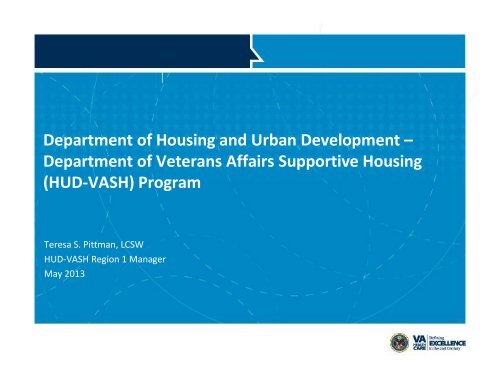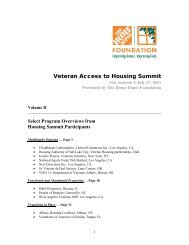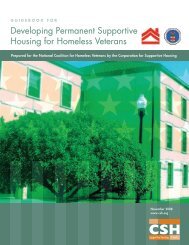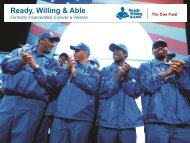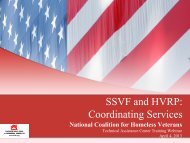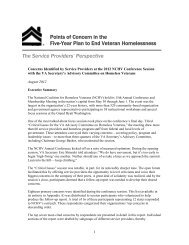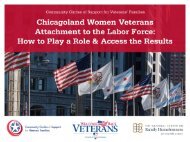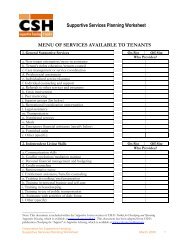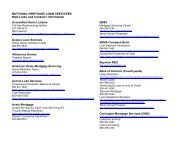HUD-VASH - National Coalition for Homeless Veterans
HUD-VASH - National Coalition for Homeless Veterans
HUD-VASH - National Coalition for Homeless Veterans
- No tags were found...
You also want an ePaper? Increase the reach of your titles
YUMPU automatically turns print PDFs into web optimized ePapers that Google loves.
Department of Housing and Urban Development –Department of <strong>Veterans</strong> Affairs Supportive Housing(<strong>HUD</strong>-<strong>VASH</strong>) ProgramTeresa S. Pittman, LCSW<strong>HUD</strong>-<strong>VASH</strong> Region 1 ManagerMay 2013
Outline• <strong>HUD</strong>-<strong>VASH</strong> Program Description• Voucher Utilization Fiscal Year (FY) 2009-March 2013• <strong>Veterans</strong> Heath Administration (VHA) <strong>Homeless</strong> Programs• Mission• Data on <strong>Homeless</strong> <strong>Veterans</strong>• Barriers• Solutions• The Way ForwardVETERANS HEALTH ADMINISTRATION1
Housing and Urban Development –<strong>Veterans</strong> Affairs Supportive Housing(<strong>HUD</strong>-<strong>VASH</strong>) Program• Two United States (US) Departments working collaboratively on acommon goal• The Department of Housing and Urban Development (<strong>HUD</strong>) hasCongressional appropriations <strong>for</strong> Housing Choice vouchers:<strong>HUD</strong>'s Appropriation<strong>HUD</strong>-<strong>VASH</strong> Appropriation Approx. Vouchers Total VouchersFY 2008 $75 M 10,150 10,150FY 2009 $75 M 10,290 20,440FY 2010 $75 M 10,096 30,536FY 2011 $50 M 7,349 37,885FY 2012 $75 M 10,450 48,335FY 2013 $75 M 10,000 58,335http://portal.hud.gov/hudportal/<strong>HUD</strong>?src=/program_offices/public_indian_housing/programs/hcv/vashVETERANS HEALTH ADMINISTRATION2
<strong>HUD</strong>-<strong>VASH</strong>The US Department of <strong>Veterans</strong> Affairs (VA) is appropriated funding <strong>for</strong><strong>HUD</strong>-<strong>VASH</strong> staff to provide case management and supportive services‣ FY 2008-2012 has 1,985 <strong>HUD</strong>-<strong>VASH</strong> Staff, to includeindependently licensed master’s level social workers, Nurses,Peer Supports, Substance Use Disorder Specialists, HousingSpecialists, administrative supports, etc.‣ Additionally, FY 2013 hiring is underway, but positions continueto be adjusted with voucher allocation changes‣ VA developing “enhanced” <strong>HUD</strong>-<strong>VASH</strong> teams, in select areaswhere there is highest need‣ VA has the capacity to ensure high level wrap-around services toVeteran participantsVETERANS HEALTH ADMINISTRATION3
<strong>HUD</strong>-<strong>VASH</strong>• <strong>HUD</strong>-<strong>VASH</strong> is the Nation’s largest supportive housing initiative thattargets homeless <strong>Veterans</strong> and their families‣ As of end of March 2013,v 48,181*, Housing Choice Vouchers (HCVs) are available <strong>for</strong>use in the <strong>HUD</strong>-<strong>VASH</strong> programv 46,031 vouchers were in usev 41,882 <strong>Veterans</strong> were housed using a <strong>HUD</strong>-<strong>VASH</strong> voucherv 86.7 percent of the FY 2012 funded positions are filledv 91.1 percent of all FY 2008-2012 funded positions arefilledVETERANS HEALTH ADMINISTRATION*Inactive Project Based Vouchers (PBV) bring the total to 48,3354
<strong>HUD</strong>-<strong>VASH</strong> PrioritiesVA and <strong>HUD</strong> agree that vouchers are to be targeted to those homeless<strong>Veterans</strong> with the highest vulnerability and need so that this resourceis maximized• Chronically homeless <strong>Veterans</strong> are the first priority• VA also assists vulnerable homeless <strong>Veterans</strong> such as:‣ Women <strong>Veterans</strong>‣ <strong>Veterans</strong> with families‣ Operation Enduring Freedom/Operation IraqiFreedom/Operation New Dawn (OEF/OIF/OND) <strong>Veterans</strong>‣ <strong>Veterans</strong> with significant disabilitiesVETERANS HEALTH ADMINISTRATION5
VETERANS HEALTH ADMINISTRATION 6
VA <strong>Homeless</strong> ServicesVA has a wide array of services <strong>for</strong> <strong>Veterans</strong> who are homeless<strong>HUD</strong>-<strong>VASH</strong> is one option in the VHA Office of <strong>Homeless</strong> Services‣ Outreach‣ <strong>National</strong> Call Center <strong>for</strong><strong>Homeless</strong> <strong>Veterans</strong>‣ Community Resource andReferral Center (CRRC)‣ Health Care <strong>for</strong> <strong>Homeless</strong><strong>Veterans</strong> Contract Beds‣ Safe Havens‣ <strong>Veterans</strong> Benefits <strong>Homeless</strong>Program‣ Grant and Per Diem TransitionalHousing‣ Supportive Services <strong>for</strong> VeteranFamilies (SSVF)‣ <strong>Homeless</strong> Veteran SupportedEmployment Program (HVSEP)‣ Domiciliary Care <strong>for</strong> <strong>Homeless</strong><strong>Veterans</strong> (DCHV)‣ Justice OutreachVETERANS HEALTH ADMINISTRATION7
VHA <strong>Homeless</strong> Programs MissionThe mission of VHA’s <strong>Homeless</strong> Program Office is to prevent and endhomelessness among <strong>Veterans</strong> and their families, and to assist in theachievement of optimal functioning and quality of life throughprovision of a comprehensive continuum of care that includes:Outreach/Education, Prevention, Treatment, Income/Employment/Benefits, and Housing/ Supportive Services provided in collaborationwith Federal, state, local governments and community partners•In 2009, the Department of <strong>Veterans</strong> Affairs launched acomprehensive, multifaceted plan to eliminate homelessness among<strong>Veterans</strong>•Housing First is a best practice that VA leadership embracesVETERANS HEALTH ADMINISTRATION8
Outreach /Education Treatment Prevention Housing Employment /Income /Benefits PartnershipsVeteran <strong>Homeless</strong>nessPovertyUnemployment/EconomicsSubstance UseMedical/Mental HealthIssuesPrior HistoryofIncarcerationLack of Af<strong>for</strong>dable HousingDomestic ViolenceUnsuccessful Transitionfrom MilitaryVETERANS HEALTH ADMINISTRATIONPrior history ofhomelessnessFamilyDecomposition9
Scope of Veteran <strong>Homeless</strong>ness• The 2012 Annual <strong>Homeless</strong> Assessment Report (AHAR) to Congress, prepared by <strong>HUD</strong>, estimates therewere 62,619 homeless <strong>Veterans</strong> on a single night in January in the United States, a 7.2 percent declinesince 2011 and a 17.2 percent decline since 2009.90,00080,00070,00060,00050,00040,00030,00020,00010,0000VETERAN PIT COUNT75,609 76,32967,49562,6192009 2010 2011 2012Notes:VETERANS - All PIT counts HEALTH are snapshots ADMINISTRATION of homelessness taken in the last week of January of the stated year10
Veteran <strong>Homeless</strong>ness DataHOMELESS VETERANS DATA FY11 FY12 FY13 YTD Q2TOTAL # SERVED IN SPECIALIZED HOMELESS OR AT-RISKPROGRAMS (includes VBA and other programs that code homeless<strong>Veterans</strong>) 210,006 257,962 223,944TOTAL # SERVED IN VHA SPECIALIZED HOMELESS OR AT-RISKPROGRAMS 157,113 200,847 165,850# SERVED NEW TO VA SERVICES IN PAST 2 YEARS 95,113 118,424 71,047# CONTACTED THROUGH OUTREACH (Uniques) 98,044 119,662 86,001# OF HOMELESS VETERANS ASSESSED 66,375 97,614 48,093# OF CHRONICALLY HOMELESS VETERANS ASSESSED 22,175 31,331 15,608% OF VETERANS ASSESSED WHO WERE CHRONICALLYHOMELESS 33% 32% 32%HOMELESS STATUS AT TIME OF ASSESSMENT% LITERALLY HOMELESS 61% 62% 61%% IMMINENT RISK FOR HOMELESSNESS 9% 10% 9%% UNSTABLY HOUSED 13% 12% 12%% STABLY HOUSED 13% 14% 15%% NOT ANSWERED 4% 2% 3%VETERANS HEALTH ADMINISTRATION11
Chronically <strong>Homeless</strong> Veteran Admissions to <strong>HUD</strong>-<strong>VASH</strong>This Chart shows the number of <strong>Veterans</strong> who met the Federalcriteria <strong>for</strong> chronically homeless at the time of admissionYear CH Admissions All Admissions Percent2009 4,951 10,059 49.2%2010 6,990 13,526 51.7%2011 8,496 15,582 54.5%2012 11,756 22,375 52.5%2013 Q1 2,645 4,375 60.5%2013 Q2 2,609 3,754 69.5%2013 (through Q2) 5,254 8,129 64.6%VETERANS HEALTH ADMINISTRATION12
Housing First• Housing First is an evidence based, cost effective approach to endinghomelessness <strong>for</strong> the most vulnerable and chronically homelessindividuals• Housing First in VA centers on quickly providing homeless <strong>Veterans</strong>with permanent housing through the <strong>HUD</strong>-<strong>VASH</strong> and/or SupportiveServices <strong>for</strong> Veteran Families (SSVF) programs and with neededservices provided• There has been an ongoing Housing First pilot project in 14 selected<strong>HUD</strong>-<strong>VASH</strong> programs• Preliminary results have been positive, and a community of learningand sharing has been created through regular monthly callscoordinated by the <strong>National</strong> Center on <strong>Homeless</strong>ness Among<strong>Veterans</strong>.VETERANS HEALTH ADMINISTRATION13
Housing First in VA• Full implementation of the Housing First model is goal• Every facility was required to:v Participate in Housing First trainingv Complete a baseline assessment of their readiness to implementHousing Firstv Cooperatively develop specific plans, with their Public HousingAuthorities, to more rapidly house <strong>HUD</strong>-<strong>VASH</strong> Veteran participants• Ongoing VISN specific Housing First technical assistance continuesto be provided by a team of advisors.VETERANS HEALTH ADMINISTRATION14
Barriers to Rapidly Housing<strong>Homeless</strong> <strong>Veterans</strong> in <strong>HUD</strong>-<strong>VASH</strong>• Change is hard and scary• Veteran participants are:v Difficult to find at timesv Ambivalentv Distrust VA/Government• No/Severely Limited Income• Processes within the various systems involved• Credit and/or Legal history• Housing Stock Limitations• Identifying appropriate applicants• Sequester ImpactVETERANS HEALTH ADMINISTRATION15
Solutions!Engaging the Veteran – Veteran centered• System change• Culture changeIncome <strong>for</strong> Deposits, etc.• <strong>Veterans</strong> Benefits Administration and Social Security Administration• <strong>Homeless</strong> Veteran Supported Employment Program (HVSEP)• Supportive Services <strong>for</strong> Veteran Families (SSVF)• Community Resources (Emergency Solutions Grant Program, Faithbasedassistance, community funds, etc.)• <strong>Veterans</strong> Employment Programs through the Department of LaborVETERANS HEALTH ADMINISTRATION16
Solutions!• Centralized processes• Stakeholder investment to remove barriers/simplify the process• Landlord Fairs• Brochures• Education about <strong>HUD</strong>-<strong>VASH</strong>• Boot Camps with leadership to make changes• Education about Regulations/Statutes• HA processes adjust to unique situations of homeless <strong>Veterans</strong>• Inspections expedited• Regular Structured Communication with other StakeholdersVETERANS HEALTH ADMINISTRATION17
Partnerships• Department of Housing and Urban Development (<strong>HUD</strong>)• 100,000 HOMES Campaign/Common Ground• Department of Health and Human Services (HHS) HS• United Stated Interagency Council on <strong>Homeless</strong>ness (USICH)• Community Governments• Public Housing Authority (PHAs)• Continuum of Care (CoCs)• Department of Labor (DOL)• Local <strong>Homeless</strong> Providers• Faith-based groups• Law En<strong>for</strong>cementVETERANS HEALTH ADMINISTRATION18
Supportive Services For Veteran Families(SSVF)• Unlike VA’s traditional <strong>Homeless</strong> Programs which focused on thetreatment and rehabilitation of the individual Veteran, prevention ofhomelessness addresses those <strong>Veterans</strong> and their families who are atimmediate risk <strong>for</strong> becoming homeless or have recently becomehomeless• The primary focus of the SSVF program is to aid Veteran families withtheir housing needs through:‣ Prevention, and‣ Rapid Re-housingIn FY 2012, SSVF served 35,363 individuals, exceeding the annualprojection of 22,000 <strong>for</strong> the fiscal year.VETERANS HEALTH ADMINISTRATION19
Supportive Services <strong>for</strong> Veteran Families(SSVF)In July 2012, VA’s SSVF Program awarded 151 community agencies in 49states and the District of Columbia totaling $100 million.– SSVF Dashboard Highlights thru February 2013 (FY 2013):‣ Served 33,604 participants.‣ Significant impact on Veteran families with 7,977 children assisted.‣ Of 20,189 Veteran participants, 2,747 are women (13.6% of<strong>Veterans</strong> served).‣ 3,501 Veteran participants are OEF/OIF/OND (17.3% of <strong>Veterans</strong>served).• Notice of Funding Availability (NOFA), published October 26, 2012, <strong>for</strong>approximately $300 million in grant funding <strong>for</strong> FY 2014• NOFA closed Feb. 1, 2013VETERANS HEALTH ADMINISTRATION20
SSVF and <strong>HUD</strong>-<strong>VASH</strong>• <strong>HUD</strong> put out a new ruling that homeless <strong>Veterans</strong> who are servedby SSVF continue to maintain <strong>HUD</strong>-<strong>VASH</strong> eligibility in “Q & A”eligibilityhttp://www.hudhre.info/index.cfm?do=viewFaqById&faqID=2246&cv=t4&keywords=<strong>HUD</strong>-<strong>VASH</strong>&facetParent=&facet=&facetItem=&isFacetSearch=&programID=0&esystemID=0&productTypeID=0&resourceTopicID=0&faqTopicID=0&faqSubTopicID=0&datefrom=&dateto=&sessionid=1DB6130DE7CD87313F4CDC7196A4B3A3&searchID=502384&searchtype=2&refererType=homeFaqSrc&listSessionFilter=&keywordinsearch=&listSearchwithin=&resultType=2• SSVF provides rapid re-housing; <strong>HUD</strong>-<strong>VASH</strong> works with those mostlikely to return to homelessness (at risk, vulnerable and chronicallyhomeless)• <strong>HUD</strong>-<strong>VASH</strong>‣ Provides the af<strong>for</strong>dable permanent housing solution‣ Wraps the social services around the Veteran participant‣ Smoothes the processes involved‣ Provides on-going case managementVETERANS HEALTH ADMINISTRATION21
The Way Forward• Continue to promote active partnerships and collaborations withFederal Departments/Agencies, Tribal Governments, State and Localmunicipalities and community organizations to include DoD Active andReserve Components and local Continuums of Care.• Develop focused ef<strong>for</strong>ts to address unique needs of homeless <strong>Veterans</strong>pecial population groups:- Rural - Women <strong>Veterans</strong>- <strong>Veterans</strong> with Families - OEF/OIF/OND <strong>Veterans</strong>- Chronically <strong>Homeless</strong> - Over age 65 Veteran- Seriously Mentally IllVETERANS HEALTH ADMINISTRATION22
The Way Forward• Develop and implement evidence-based models of care• Through the use of the <strong>Homeless</strong> Registry, createlearning communities that share data, best practices andare results driven.• Improve homeless <strong>Veterans</strong>’ employability• Support Veteran’s recovery from homelessness• Advance Veteran’s integration into their community• Promote Veteran independence from initial contactthrough graduation from case managementVETERANS HEALTH ADMINISTRATION23
Questions…For more in<strong>for</strong>mation on VA’s programs <strong>for</strong> <strong>Homeless</strong> <strong>Veterans</strong>:http://www.va.gov/HOMELESS/index.aspVETERANS HEALTH ADMINISTRATION24


